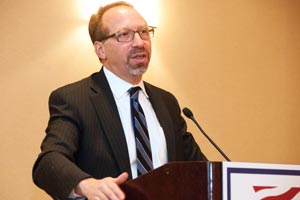Rogoff: Invest in Resilient Infrastructure

Undersecretary for policy Peter Rogoff said at the Nov. 12 Eno Center for Transportation event in Charleston that there is a sound business case for investing in resilient infrastructure and doing so might be transportation’s “most significant challenge this century.”
Rogoff, who was elevated earlier this year to his current post, ranking third highest, after serving as Federal Transit administrator since 2009, said many in Congress and the bureaucracy are skeptical of this.
He challenged them with the observation by philosopher Jean-Paul Sartre: “To think new thoughts you have to break the bones in your head.”
“We may have to spend a little bit more to have an investment that will stand the test of time,” Rogoff said, adding, “We can see with a very clear lens . . . what will happen in the next 30 years” to ports and other components of transportation systems.
As an example, Rogoff said a DOT grant helped pay not just for rebuilding but for improvements in Joplin, Missouri, after severe damage from tornadoes in 2011.
Eno President Joshua Schank said basic planning for daily operations also helps improve resilience, and a South Carolina official gave an example.
Christy Hall, deputy secretary for engineering of South Carolina’s DOT, said strategic placement of materials before a disaster happens makes recovery go more quickly. Specifically, Hall said she stashes salt around the state in case of ice storms, such as the one that walloped the state at the start of this year.
This was part of her call for self-reliance, which is applicable to companies as well as governments.
“You have to drive your own recovery. The cavalry won’t come to your rescue,” Hall said.
Hall’s boss, Janet Oakley, the department’s secretary, strongly endorsed contingency planning but said it should be done on a state or local level, not federal.
“We need a collaborative approach, but one size won’t fit all. A lot depends upon the environment you’re in,” Oakley said. By example, she noted that Charleston has invested in an underground system to handle storm-water management because of its needs as a low-lying city.
There were several calls for keeping the public better informed, including remarks by Brian Pallasch, an executive with the American Society of Civil Engineers. Victims of Hurricane Katrina said in interviews that they lived near levees but didn’t know what they were until after they burst.
“We need to educate the public,” Pallasch said.




